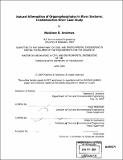| dc.contributor.advisor | Peter Shanahan and Philip M. Gschwend. | en_US |
| dc.contributor.author | Andrews, Matthew B. (Matthew Bryan), 1981- | en_US |
| dc.contributor.other | Massachusetts Institute of Technology. Dept. of Civil and Environmental Engineering. | en_US |
| dc.coverage.spatial | n-us-ga | en_US |
| dc.date.accessioned | 2006-03-24T18:23:02Z | |
| dc.date.available | 2006-03-24T18:23:02Z | |
| dc.date.copyright | 2004 | en_US |
| dc.date.issued | 2004 | en_US |
| dc.identifier.uri | http://hdl.handle.net/1721.1/30138 | |
| dc.description | Thesis (M. Eng.)--Massachusetts Institute of Technology, Dept. of Civil and Environmental Engineering, 2004. | en_US |
| dc.description | Includes bibliographical references. | en_US |
| dc.description.abstract | Three organophosphoric acid triesters, tributyl phosphate (TBP), tris(2-chloroethyl) phosphate (TCEP), and tris(2-butoxyethyl) phosphate (TBEP) have been detected in surface waters across the world, primarily the result of sewage treatment plant discharge. Despite concentrations as low as a few parts per trillion, there is growing concern over the potential impact these compounds can have on human and environmental health. This study is an attempt to identify the presence of natural removal processes for these three organophosphoric acid triesters within the Chattahoochee River near Atlanta, Georgia, USA. Samples were collected during the month of January at various sites along the Chattahoochee River. They were subsequently analyzed for concentration of all three organophosphoric acid triesters. These concentrations were then implemented in the construction of mass balances with the intention of identifying a sink term for each compound. A separate set of samples were collected and analyzed at various times over a 24-hour period. These results were used to calculate a biodegradation rate for each organophosphoric acid triester within the Chattahoochee River. The results demonstrate that these three compounds are persistent in the Chattahoochee River over the course of one day. This conclusion is specific to the time of year and location of sampling. Despite findings of no significant natural attenuation, this study should be used as a foundation for future research into the removal of low-level contaminants within the Chattahoochee River. | en_US |
| dc.description.statementofresponsibility | by Matthew B. Andrews. | en_US |
| dc.format.extent | 120, [2] p. | en_US |
| dc.format.extent | 5692829 bytes | |
| dc.format.extent | 5692635 bytes | |
| dc.format.mimetype | application/pdf | |
| dc.format.mimetype | application/pdf | |
| dc.language.iso | eng | en_US |
| dc.publisher | Massachusetts Institute of Technology | en_US |
| dc.rights | M.I.T. theses are protected by copyright. They may be viewed from this source for any purpose, but reproduction or distribution in any format is prohibited without written permission. See provided URL for inquiries about permission. | en_US |
| dc.rights.uri | http://dspace.mit.edu/handle/1721.1/7582 | |
| dc.subject | Civil and Environmental Engineering. | en_US |
| dc.title | Natural attenuation of organophosphates in river systems: Chattahoochee River case study | en_US |
| dc.type | Thesis | en_US |
| dc.description.degree | M.Eng. | en_US |
| dc.contributor.department | Massachusetts Institute of Technology. Department of Civil and Environmental Engineering | |
| dc.identifier.oclc | 56016937 | en_US |
